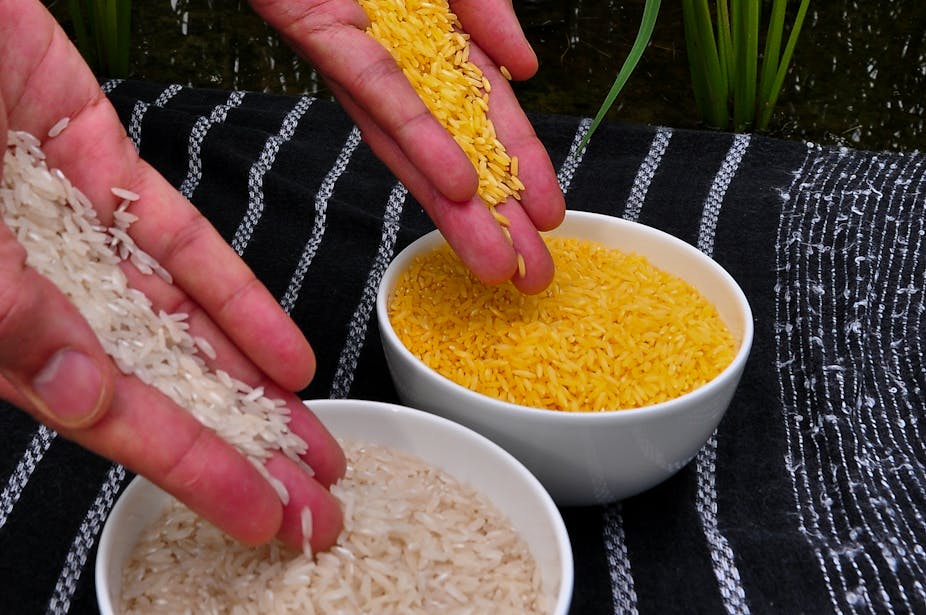Recently Zac Goldsmith MP – a former editor of The Ecologist, no less – branded the views of Environment Secretary Owen Patterson as “grotesque” after the minister called anti-GM campaigners “wicked”. Mr Goldsmith stated:
GM has never been about feeding the world, or tackling environmental problems. It is and has always been about control of the global food economy by a tiny handful of giant corporations. It’s not wicked to question that process. It is wicked not to.
By saying as much Mr Goldsmith drags up arguments that are out of date and out of place. Golden rice is a bio-fortified, genetically modified Oryza sativa rice crop that offers a nutritionally enriched staple for those who cannot afford or obtain a balanced diet rich in fruit and vegetables. Golden rice can be produced by subsistence farmers in developing countries using varieties adapted to local conditions. Access to the technology is free.
Lack of vitamin A causes blindness and death in over a million children under five that do not have access to a balanced diet, every year. For many their staple diet is rice, but rice does not produce vitamin A in the grain even though it has all the genes necessary to do so (and in fact does so in the leaves).
The inventors of golden rice, Ingo Potrykus of the Swiss Federal Institute of Technology and Peter Beyer of the University of Freiburg, worked out how to “turn on” the synthesis of vitamin A in the edible grain itself by inserting two genes, resulting in a rice variety with boosted vitamin A levels. Widespread adoption of golden rice could decrease deaths due to vitamin A deficiency by an estimated 25% or more. This is a result, and a crop, that could not be achieved using conventional breeding.
From the outset golden rice was a public good project governed by the Golden Rice Humanitarian Board. Swiss biotech company Syngenta contributed to the project by developing improved varieties in their labs but arranged that any intellectual property associated with golden rice was licensed free of charge to allow the technology to be available to resource-poor farmers who are permitted to save seed.
There is no catch or hidden agenda, yet anti GM campaigners continue to have a blanket condemnation on the technology, linking it to corporate conspiracies and control of the global food economy. The science of genetic modification has moved on considerably over the last 15 years and has answered many of the concerns raised about GM and its commercial applications.
Indeed golden rice nullifies all the arguments against GM: it has not been developed for commercial profit; it fulfils an urgent need by complementing traditional interventions; it presents a sustainable, cost-free solution, not requiring other resources; those who benefit are poor and disadvantaged; it is given free of charge and without restrictions to subsistence farmers; it does not create any new dependencies and can be grown without any additional inputs; it does not create advantages to rich landowners; it can be resown every year from the saved harvest; it does not reduce agricultural or natural biodiversity; and there is no conceivable threat to the environment or to human health.
Yet protestors continue to promote misinformation and destroy field trials. Many refuse to engage in a meaningful dialogue and discuss GM issues on a case-by-case, evidential basis. For the first time since the introduction of GM crops almost two decades ago, developing countries now grow more than industrialised countries, contributing to food security and alleviating poverty in some of the world’s most vulnerable regions. The technology is not forced onto growers. Today over 17m farmers in 29 countries grow GM crops.
Paradoxically, in many examples of genetic modification, through their actions anti-GM campaigners have shot themselves in the foot and driven some of the technology into the hands of ever-larger companies. Only these firms can afford the excessive, expensive and needless regulatory processes that must be repeated in every country due to the lack of internationally accepted standards. Subsistence farmers and starving children are the collateral victims.
In the case of golden rice, there is no giant corporate conspiracy – merely a desire by motivated scientists to address global health issues within a framework of subsistence farming. Mr Goldsmith is trying to resurrect a debate that might have had currency 15 years ago but which is no longer relevant in scientific or socioeconomic terms. Were he to look at the evidence, he might embrace technology for the contribution it can make to producing food that is healthier for humans and for the environment.

